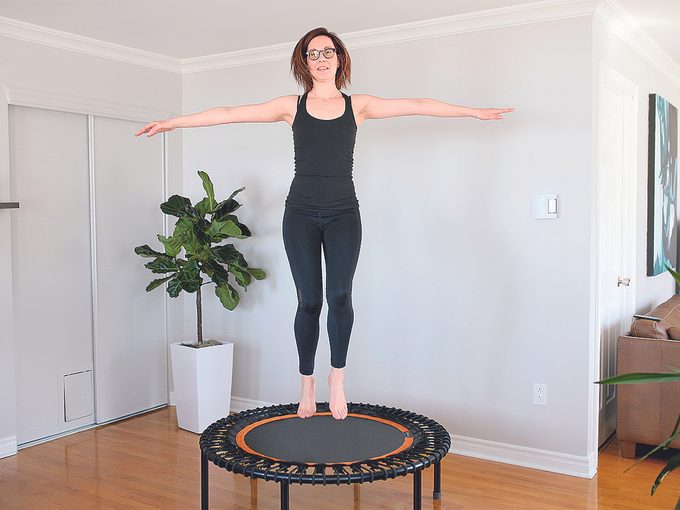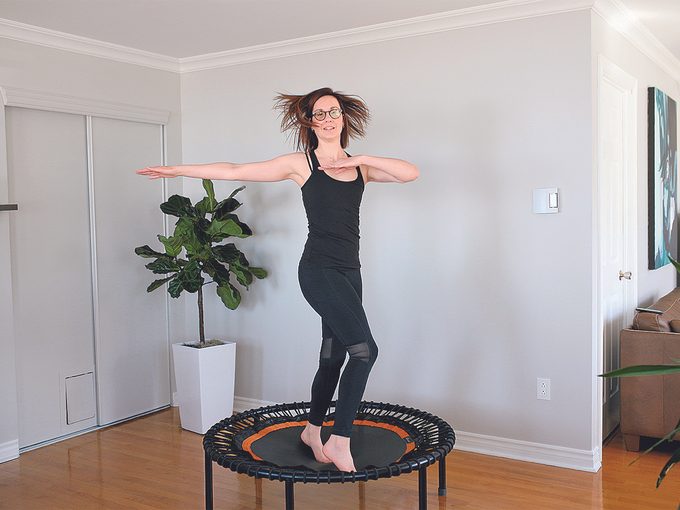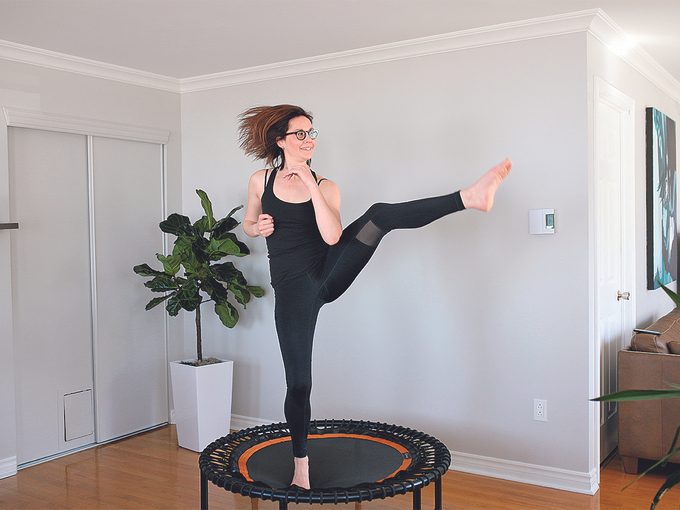Gyms and studios have been shut down because of COVID-19 restrictions for over a year now meaning that our homes are now our gyms (along with our offices, restaurants, movie theatresthe list goes on). While some of us have created a patchwork at-home exercise routine, maybe with an exercise app or a fancy new piece of equipment, others with smaller homes, tighter budgets or, ahem, a distinct lack of motivation know those options arent always realistic.Enter the rebounder trampoline, also known as a fitness trampoline, a mini trampoline or simply a rebounder. These compact pieces of equipment have a firm jumping mat that gives you a smaller and lower bounce than the trampolines of your childhood. Though rebounders arent the same as trampolines for kids, the fun factor is right up there. Plus, you dont need too much space to get rebounding just enough to stretch out your arms and about three feet of clearance overhead.There are two types of rebounders: spring-loaded and bungee cord. Spring-loaded versions get their bounce from metal coils under the mat, while bungee-cord trampolines use elastic (or sometimes metal) cords to tighten the jumping mat. The latter tends to have a softer bounce, which can make for a more intense workout because it allows you to sink deeper.(Related:7 Best Cardio Workouts You Can Do at Home)A 1980 study in the Journal of Applied Physiology found that jumping on a trampoline is a more effective cardio workout than jogging, while also being easier on the joints. Plus, rebounder exercises work virtually every muscle in your lower body. People are always like, Oh, Im just going to jump up and down, and its going to be super easy, says Naomi Joy Gallagher, a Vancouver-based personal trainer who also teaches rebounder workouts on YouTube as Naomi Joy Fitness. But the thing is, the workout comes from actually pushing down into the trampoline, and that just transforms your workout.As with any workout, form is key when exercising with a rebounder. While you might be tempted to hop around on your toes like you did as a kid, the exercise really comes from pushing down into the trampoline (not jumping), so the footwork and lower-body movements are important to master. Plus, maintaining the right position will help avoid injury.First, set up your stance: Stand in the middle of the trampoline with your feet hip-width apart, knees slightly bent, spine in the neutral position and a slight tilt at the hips to activate the core and glutes (but not so much that youre leaning forward). Make sure your shoulders are back and down, and your core is activated before you start. Then, push down into the trampoline and get bouncing!(Related:Why Exercise Can Be the Most Effective Way to Relieve Stress)The most common mistake is that people jump up instead of pressing down, says Gallagher. When [you push down] with proper form, you are using the deep core muscles and your lower-body strength, and increasing your heart rate.Of course, there are a few risks to be aware of. If you have weak knees or ankles, or if youre unbalanced, invest in a model with a detachable balance bar to help with stability. Gallagher also advises users to be careful when getting on and off the trampoline, especially if youve worked up a sweat they can get really slippery.For some people, especially those with vaginas, jumping around on a trampoline might mean some urinary incontinence, aka pee leakage. When you jump, theres an increase in intra-abdominal pressure, meaning that there is a strong, sudden downward pressure on the bladder, says Michiko Caringal, owner of Happy Down There, a pelvic floor physiotherapy clinic in Toronto. Ideally, the pelvic floor muscles would contract to support the bladder. However, if you experience incontinence, there is a likelihood that the pelvic floor muscles are either weak or uncoordinated, or have low endurance.(Related:Your Guide to a Leak-Free Workout (Yes, Were Talking About Pee))Luckily, rebounding can help strengthen and build endurance in your pelvic floor. There are a few things that can make the whole experience a bit less, well, wet. First, Caringal suggests getting a physical assessment to figure out where youre at. Also, take breaks between reps. I always suggest doing side steps in between reps to allow the pelvic floor muscles to reset before another jump, Caringal says. And, if you were told by a physio to do Kegels, learn how to do them properly.Once you master the basics, there are a few ways to level up your workout. The Internet is full of videos for both beginner and experienced rebounders. More advanced routines include moves like kicks and running in place to up the ante. You can also add small hand weights, ankle weights and resistance bands to add a killer strength workout to your cardio. There are a ton of videos online that will help you build your skills and stretch your endurance. A quick search will call up creators like Gallagher, or studios devoted to rebounding like Montreal’s House of Bounce, which now offers virtual classes an an on-demand library of videos to choose from in lieu of their usual IRL studio classes.The biggest joy of rebounding is just how fun it is, Gallagher says. If you cant get outside for a walk, just go on the trampoline for five minutes. Its just such a fun feeling that you cant help but smile.Below, House of Bounce instructor Genevive Claveau demonstrates four moves to amp up your at-home routine:
1. Scissors
Start with your one foot back and one foot forward. Then, bounce down and reverse the positioning of your feet as you come up. Continue to bounce and reverse your feet, as if you were cross-country skiing and pump your arms.(Related:This Is the Best Fitness App for You)
 2. Extension
2. Extension
Start with your feet planted shoulder-width apart. Then, as you bounce down, reach your right arm up and over and extend your right leg to the side, opening up that side of your body. Return to neutral and repeat the move on the other side, extending your left arm up and over and left leg to the side.
 3. Twist
3. Twist
Start with your feet shoulder-width apart, knees bent and core engaged, then bounce into the trampoline and twist your feet and legs to the right. On the next bounce, return to centre. On the next bounce, point your toes to the left and twist to your left. Return to centre, and start from the top. Pump your arms to keep your upper body engaged.(Related:The Types of Stretching Fitness Experts Recommendand One They Avoid)
4. Open side kicks
Try this move once youre ready for a bit of a challenge. With your feet shoulder-width apart and hips squared, bounce down. As the trampoline rebounds and you move up, kick your right leg out to the right side. Do the same with your left side. You can do this move either one side at a time, or with your right and left legs alternating.Next, these are the health benefits for your mind and body of biking.
The post This Is Why You Need a Rebounder Trampoline at Home appeared first on Best Health Magazine Canada.


0 Commentaires